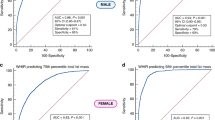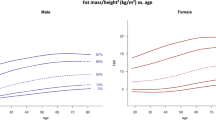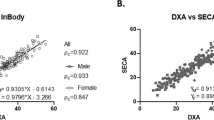Abstract
Objectives
Accelerated gain in fat mass (FM) in early life increases the risk for adult diseases. Longitudinal data on infant body composition are crucial for clinical and research use, but very difficult to obtain due to limited measurement tools and unsuccessful measurements between age 6–24 months. We compared FM% by dual-energy X-ray absorptiometry (DXA), with cushion to reduce movement artifacts, with FM% by air-displacement plethysmography (ADP) and evaluated the reliability of this cushion during DXA by comparing FM% with and without cushion. Subsequently, we constructed sex-specific longitudinal body composition charts from 1–24 months.
Methods
In 692 healthy, term-born infants (Sophia Pluto Cohort), FM% was measured by ADP from 1–6 months and DXA with cushion from 6–24 months. At 6 months, FM% was measured in triplicate by ADP and DXA with and without cushion(n = 278), later on in smaller numbers.
Results
At 6 months, mean FM% by DXA with cushion was 24.1 and by ADP 25.0, mean difference of 0.9% (Bland–Altman p = 0.321, no proportional bias). Mean FM% by DXA without cushion was 12.5% higher compared to ADP (Bland–Altman p < 0.001). DXA without cushion showed higher mean FM% compared to DXA with cushion (+11.6%, p < 0.001) at 6 months. Longitudinally, FM% increased between 1–6 months and decreased from 6–24 months(both p < 0.001).
Conclusions
In infants, DXA scan with cushion limits movement artifacts and shows reliable FM%, comparable to ADP. This allowed us to construct longitudinal body composition charts until 24 months. Our study shows that FM% increases from 1–6 months and gradually declines until 24 months.
This is a preview of subscription content, access via your institution
Access options
Subscribe to this journal
Receive 12 print issues and online access
$259.00 per year
only $21.58 per issue
Buy this article
- Purchase on Springer Link
- Instant access to full article PDF
Prices may be subject to local taxes which are calculated during checkout



Similar content being viewed by others
References
Pietrobelli A, Agosti M, MeNu G. Nutrition in the first 1000 days: ten practices to minimize obesity emerging from published science. Int J Environ Res Public Health. 2017;14:1491. https://doi.org/10.3390/ijerph14121491.
Roy SM, Spivack JG, Faith MS, Chesi A, Mitchell JA, Kelly A et al. Infant BMI or weight-for-length and obesity risk in early childhood. Pediatrics 2016;137.
Leunissen RW, Kerkhof GF, Stijnen T, Hokken-Koelega A. Timing and tempo of first-year rapid growth in relation to cardiovascular and metabolic risk profile in early adulthood. JAMA. 2009;301:2234–42. https://doi.org/10.1001/jama.2009.761.
Odegaard AO, Choh AC, Nahhas RW, Towne B, Czerwinski SA, Demerath EW. Systematic examination of infant size and growth metrics as risk factors for overweight in young adulthood. PLoS ONE. 2013;8:e66994.
Ay L, Hokken-Koelega ACS, Mook-Kanamori DO, Hofman A, Moll HA, Mackenbach JP. et al. Tracking and determinants of subcutaneous fat mass in early childhood: the Generation R Study. Int J Obes. 2008;32:1050. https://doi.org/10.1038/ijo.2008.76.
Wells JCK. Body composition in infants: evidence for developmental programming and techniques for measurement. Rev Endocr Metab Disord. 2012;13:93–101. https://doi.org/10.1007/s11154-012-9213-9.
Breij LM, Steegers-Theunissen RPM, Briceno D, Hokken-Koelega ACS. Maternal and fetal determinants of neonatal body composition. Horm Res Paediatr.2015;84:388–95. https://doi.org/10.1159/000441298.
Demerath EW, Fields DA. Body composition assessment in the infant. Am J Hum Biol. 2014;26:291–304.
Butte NF, Hopkinson JM, Wong WW, Smith EO, Ellis KJ. Body composition during the first 2 years of life: an updated reference. Pediatr Res. 2000;47:578–85.
Fomon SJ, Haschke F, Ziegler EE, Nelson SE. Body composition of reference children from birth to age 10 years. Am J Clin Nutr. 1982;35(5 Suppl):1169–75.
Harrington TA, Thomas EL, Frost G, Modi N, Bell JD. Distribution of adipose tissue in the newborn. Pediatr Res. 2004;55:437–41.
Mazahery H, von Hurst PR, McKinlay CJD, Cormack BE, Conlon CA. Air displacement plethysmography (pea pod) in full-term and pre-term infants: a comprehensive review of accuracy, reproducibility, and practical challenges. Matern Health Neonatol Perinatol. 2018;4:12.
Breij Laura M, Kerkhof Gerthe F, De Lucia Rolfe E, Ong Ken K, Abrahamse‐Berkeveld M, Acton D. et al. Longitudinal fat mass and visceral fat during the first 6 months after birth in healthy infants: support for a critical window for adiposity in early life. Pediatr Obes. 2017;12:286–94. https://doi.org/10.1111/ijpo.12139.
Breij LM, Abrahamse-Berkeveld M, Acton D, De Lucia Rolfe E, Ong KK, Hokken-Koelega ACS. Impact of early infant growth, duration of breastfeeding and maternal factors on total body fat mass and visceral fat at 3 and 6 months of age. Ann Nutr Metab. 2017;71:203–10.
Zanini RdV, Santos IS, Chrestani MAD, Gigante DP. Body fat in children measured by DXA, air-displacement plethysmography, TBW and multicomponent models: a systematic review. Matern Child Health J. 2015;19:1567–73. https://doi.org/10.1007/s10995-015-1666-5.
COSMED. Bod Pod Brochure ENGLISH. https://www.cosmed.com/hires/Bod_Pod_Brochure_EN_C03837-02-93_A4_print.pdf.
Fields DA, Gunatilake R, Kalaitzoglou E. Air displacement plethysmography: cradle to grave. Nutr Clin Pr. 2015;30:219–26.
Godang K, Qvigstad E, Voldner N, Isaksen GA, Frøslie KF, Nøtthellen J. et al. Assessing body composition in healthy newborn infants: reliability of dual-energy X-ray absorptiometry. J Clin Densitom. 2010;13:151–60. https://doi.org/10.1016/j.jocd.2010.01.121.
de Knegt VE, Carlsen EM, Bech Jensen JE, Lade Rasmussen AM, Pryds O. DXA performance in a pediatric population: precision of body composition measurements in healthy term-born infants using dual-energy X-ray absorptiometry. J Clin Densitom. 2015;18:117–23.
Koo WW, Walters JC, Hockman EM. Body composition in human infants at birth and postnatally. J Nutr. 2000;130:2188–94.
van der Sluis IM, de Ridder MA, Boot AM, Krenning EP, de Muinck, Keizer-Schrama SM. Reference data for bone density and body composition measured with dual energy x ray absorptiometry in white children and young adults. Arch Dis Child. 2002;87:341–7.
IAEA. Body composition assessment from birth to two years of age. In: International Atomic Energy Agency. Human Health Series. Vienna, Austria; 2013; 22.
Fields David A, Demerath Ellen W, Pietrobelli A, Chandler‐Laney Paula C. Body composition at 6 months of life: comparison of air displacement plethysmography and dual‐energy X‐ray absorptiometry. Obesity. 2012;20:2302–6. https://doi.org/10.1038/oby.2012.102.
Shepherd JA, Sommer MJ, Fan B, Powers C, Stranix-Chibanda L, Zadzilka A, et al. Advanced analysis techniques improve infant bone and body composition measures by dual-energy X-ray absorptiometry. J Pediatr. 2017;181:248–253 e243.
Wrottesley SV, Pisa PT, Micklesfield LK, Pettifor JM, Norris SA. A comparison of body composition estimates using dual-energy X-ray absorptiometry and air-displacement plethysmography in South African neonates. Eur J Clin Nutr. 2016;70:1254. https://doi.org/10.1038/ejcn.2016.91.
COSMED. PEA POD Infant body composition system operator’s manual. 2015: 205.
Healthcare GE Frequently asked questions; advanced body composition application overview. 2012.
Rigby RA, Stasinopoulos DM. Generalized additive models for location, scale and shape. J R Stat Soc: Ser C (Appl Stat). 2005;54:507–54. https://doi.org/10.1111/j.1467-9876.2005.00510.x.
Rigby RA, Stasinopoulos DM. Smooth centile curves for skew and kurtotic data modelled using the Box–Cox power exponential distribution. Stat Med. 2004;23:3053–76. https://doi.org/10.1002/sim.1861.
Ma G, Yao M, Liu Y, Lin A, Zou H, Urlando A. et al. Validation of a new pediatric air-displacement plethysmograph for assessing body composition in infants. Am J Clin Nutr. 2004;79:653–60.
Carberry AE, Colditz PB, Lingwood BE. Body composition from birth to 4.5 months in infants born to non-obese women. Pediatr Res. 2010;68:84. https://doi.org/10.1203/PDR.0b013e3181df5421.
Fields DA, Gilchrist JM, Catalano PM, Gianni ML, Roggero PM, Mosca F. Longitudinal body composition data in exclusively breast-fed infants: a multicenter study. Obes (Silver Spring). 2011;19:1887–91. https://doi.org/10.1038/oby.2011.11.
Andersen GS, Girma T, Wells JC, Kaestel P, Leventi M, Hother AL, et al. Body composition from birth to 6 mo of age in Ethiopian infants: reference data obtained by air-displacement plethysmography. Am J Clin Nutr. 2013;98:885–94.
Sauder KA, Kaar JL, Starling AP, Ringham BM, Glueck DH, Dabelea D. Predictors of infant body composition at 5 months of age: The Healthy Start Study. J pediatrics. 2017;183:94–99.e91. https://doi.org/10.1016/j.jpeds.2017.01.014.
Fields DA, Krishnan S, Wisniewski AB. Sex differences in body composition early in life. Gend Med. 2009;6:369–75.
Hawkes CP, Hourihane JO, Kenny LC, Irvine AD, Kiely M, Murray DM. Gender- and gestational age-specific body fat percentage at birth. Pediatrics. 2011;128:e645–651. https://doi.org/10.1542/peds.2010-3856.
Ay L, Van Houten VA, Steegers EA, Hofman A, Witteman JC, Jaddoe VW. et al. Fetal and postnatal growth and body composition at 6 months of age. J Clin Endocrinol Metab. 2009;94:2023–30. https://doi.org/10.1210/jc.2008-2045.
Acknowledgements
We thank all infants and their parents for participating in the Sophia Pluto Study. Furthermore, we greatly acknowledge Mrs. J. van Nieuwkasteele, Mrs. M. Huibregtse-Schouten, Mrs. C. Bruinings-Vroombout, Mrs. E. Lems, Ms. N. Khieroe, Mrs. S. Besteman-Voortman, Mrs. J. Bontenbal-van de Wege, research nurses, for their assistance with data collection.
Funding
A.C.S.H.-K. received an independent research grant by Danone Nutricia Research.
Author information
Authors and Affiliations
Contributions
L.M.B., D.A. and A.C.S.H.-K. designed research; K.S.dF., I.A.L.P.vB., L.M.B. and A.C.S.H.-K. conducted research; AS provided essential materials; K.S.dF. analyzed the data; K.S.dF., I.A.L.P.vB., W.J.G, D.A. and A.C.S.H.-K. wrote the paper; K.S.dF. had primary responsibility for final content. All authors were involved in writing the manuscript and approved the submitted version.
Corresponding author
Ethics declarations
Conflict of interest
The Sophia Pluto Study is an investigator-initiated study. D.A. is an employee of Danone Nutricia Research.
Additional information
Publisher’s note Springer Nature remains neutral with regard to jurisdictional claims in published maps and institutional affiliations.
Online Trial Registry: NTR, NL7833.
Supplementary information
Rights and permissions
About this article
Cite this article
de Fluiter, K.S., van Beijsterveldt, I.A., Goedegebuure, W.J. et al. Longitudinal body composition assessment in healthy term-born infants until 2 years of age using ADP and DXA with vacuum cushion. Eur J Clin Nutr 74, 642–650 (2020). https://doi.org/10.1038/s41430-020-0578-7
Received:
Revised:
Accepted:
Published:
Issue Date:
DOI: https://doi.org/10.1038/s41430-020-0578-7
This article is cited by
-
Growth and body composition trajectories in infants meeting the WHO growth standards study requirements
Pediatric Research (2022)
-
Body composition from birth to 2 years in term healthy Indian infants measured by deuterium dilution: Effect of being born small for gestational age and early catch-up growth
European Journal of Clinical Nutrition (2022)
-
A comparative study using dual-energy X-ray absorptiometry, air displacement plethysmography, and skinfolds to assess fat mass in preterms at term equivalent age
European Journal of Pediatrics (2021)



